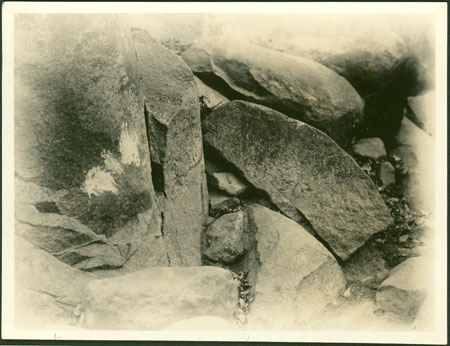Jumjum rainstones

103 x 76 mm | Print gelatin silver
Condition:
Fading [EE 1989]
Date of Print:
Unknown
Previous PRM Number:
EP.D.161
Previous Other Number:
N
Accession Number:
1998.344.161.2
Description:
Uli, the Jumjum Mun nial and Mun dyong ('man of rain' and 'man of god') of Jebel Wadega had led Evans-Pritchard to where he kept his rainstones in a hole in a cleft in the rocks near the bottom of the hill covered by a pot sherd and some large stones.
Failing in his attempts to purchase one or even remove them to handle, Evans-Pritchard photographed their location, although the thirty or so pebbles he mentions as comprising the rainstones are not visible here.
Photographer:
Edward Evan Evans-Pritchard
Date of Photo:
1926 November - December
Region:
Blue Nile Jebel Wadega
Group:
Jumjum
NamedPerson:
Uli
PRM Source:
Edward Evan Evans-Pritchard
Acquired:
Donated 1966
Other Owners:
E. E. Evans-Pritchard Collection
Class:
Religion , Ritual Object
Documentation:
Original catalogue lists in Manuscript Collections. Additional material in related documents files. [CM 27/9/2005]
Primary Documentation:
PRM Accession Records - Accession Book Entry [p.
98] 1966.27 [1 - 24] G[ift] PROFESSOR E.
E.
EVANS-PRITCHARD; INST.
OF SOCIAL ANTHROPOLOGY, 51 BANBURY RD.
OXFORD - 1966.27.19 - S.
SUDAN, DARFUNG.
VARIOUS TRIBES.
Box of negatives in envelopes, [1 - 242] & 1966.27.20 - Box of prints of these negatives [refers to object 1966.27.19] [1 - 242], in envelopes.
Manual Catalogues [typewritten, entitled "Ingassana"] - 161. Rain-stones. (JumJum). N
Note on print reverse ms pencil - "N"
Notes on card mount ms pencil - "fading 11/11/86 EE"
Manual Catalogues [typewritten, entitled "Ingassana"] - 161. Rain-stones. (JumJum). N
Note on print reverse ms pencil - "N"
Notes on card mount ms pencil - "fading 11/11/86 EE"
Other Information:
In Ethnological Observations in Dar Fung, Sudan Notes and Records XV Part I, 1932, page 25, E.
E.
Evans-Pritchard discusses his meeting with Uli on Jebel Wadega in some detail.
In particular he notes that '..I then accompanied him to the bottom of the hill where he kept his rainstones in a hole in the rock.
These were covered by a potsherd over which some large stones had been laid and comprised about thirty rounded pebbles of various shapes and sizes...it was difficult to see into the hole properly and my guide did not seem very anxious that I should finger them.
I offered him a large sum of money to be allowed to take one of his pebbles away, pointing out that he had a big collection, but my offer was refused.' [Chris Morton 13/2/2004]
Recorder:
Christopher Morton 13/2/2004 [Southern Sudan Project]

